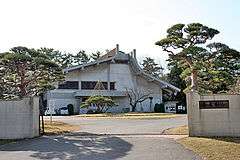Homma Museum of Art
| Homma Museum of Art | |
|---|---|
| 本間美術館 | |
 | |
| General information | |
| Address | 7-7 Onari-chō |
| Town or city | Sakata, Yamagata Prefecture |
| Country | Japan |
| Coordinates | 38°55′24″N 139°50′32″E / 38.923402°N 139.842107°ECoordinates: 38°55′24″N 139°50′32″E / 38.923402°N 139.842107°E |
| Opened | 1947 |
| Website | |
| Official website | |
Homma Museum of Art (本間美術館 Homma bijutsukan) opened in Sakata, Yamagata Prefecture, Japan, in 1947.
Setting
The Seienkaku (清遠閣) residence was built in 1813 by the fourth head of the Homma Family (本間氏). Visitors include members of the Sakai and Uesugi clans, lords of the Shōnai and Yonezawa Domains, as well as in 1925 the future Shōwa emperor - the second storey had been added in 1908 in advance of a planned visit by the future Taishō emperor.[1][2] The Kakubu-en (鶴舞園) or "Dancing Crane" Gardens, designated a Place of Scenic Beauty, incorporate Mount Chōkai by way of borrowed scenery.[1][3] The new exhibition hall was added in 1968.[1][4]
Collection
.jpg)
The collection of some 2,500 objects includes a Kamakura-period edition of Ise Monogatari and three other Important Cultural Properties, works by Kanō Tan'yū, Nagasawa Rosetsu, Itō Jakuchū, Shiba Kōkan, Matsumura Goshun, Okada Hankō, Kishi Ganku, Kita Genki (喜多元規), Fukuhara Gogaku (福原五岳), Minagawa Kien (皆川淇園), Yasuda Raishū (安田雷洲), and Kuroda Seiki, as well as Goryeo celadons, raku ware by Chōjirō, lacquerware, sculptures, and Japanese traditional dolls.[1][6]
See also
- List of Places of Scenic Beauty of Japan (Yamagata)
- List of Cultural Properties of Japan - paintings (Yamagata)
References
| Wikimedia Commons has media related to Homma Museum of Art. |
- 1 2 3 4 "Homma Museum of Art". Cabinet Office, Government of Japan. Retrieved 18 October 2015.
- ↑ 公益財団法人 本間美術館 [Homma Museum of Art] (in Japanese). Agency for Cultural Affairs. Retrieved 18 October 2015.
- ↑ 本間氏別邸庭園(鶴舞園) [Honma Family Detached Residence Gardens (Kakubu-en)] (in Japanese). Agency for Cultural Affairs. Retrieved 18 October 2015.
- ↑ "Museums in Yamagata - Homma Museum of Art". Yamagata Prefectural Museum. Retrieved 18 October 2015.
- ↑ 紙本淡彩鼬図 伝円山応挙筆 [Weasels, light colour on paper, attributed to Maruyama Okyo] (in Japanese). Yamagata Prefecture. Retrieved 18 October 2015.
- ↑ コレクション [Collection] (in Japanese). Homma Museum of Art. Retrieved 18 October 2015.
External links
- (Japanese) Homma Museum of Art
- (Japanese) Collection